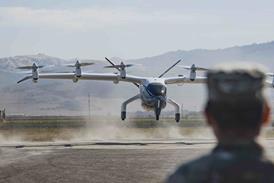Andrew Doyle/BIRMINGHAM
DEVELOPMENT OF "smart" self-sensing polymer composites could significantly reduce the through-life costs of using carbonfibre composite structures in aircraft, according to the UK's Defence Research Agency (DRA).
Smart materials are embedded with sensing systems which provide data on the integrity of a structure, making them particularly useful in carbonfibre composites where so-called barely-visible impact damage (BVID) can occur because of dropped tools or large hailstones.
Dr Martin Kemp of the DRA's Farnborough-based structural materials centre, speaking on 17 October at the Aerotech '95 conference in Birmingham, UK, said that smart self-sensing composites which can be used to detect damage by monitoring the electrical conductivity of carbonfibre materials are an "attractive concept".
The DRA is now searching for suitable civil or military aircraft testbeds on which to install a prototype system, and is holding discussions with airframe manufacturers.
"A smart solution to structural health monitoring (SHM) is now perceived to be a strong contender for composite structures in terms of the potential through-life cost savings and safety benefits," says Kemp.
The DRA hopes that self-sensing composites will lead to more reliable SHM systems, which can be incorporated into new aircraft or retrofitted to existing airframes. Previous research into smart damage-detection systems has focused on the use of "discrete" sensors, which monitor a small, localised area.
To build a practical system, these discrete sensors have to be placed close together, increasing weight and complexity.
The self-sensing composites developed at the DRA, however, monitor "...changes in a global physical property of the structure, rather than using discrete sensors which monitor at a local point", says Kemp.
The resulting data are analysed on board the aircraft using a single central processor, or a "distributed" system with processors located around the structure.
Distributing the processors would help to cut down the number of connecting cables in the system, reducing its weight and complexity.
"Ideally, we would like to have some of the damage detection function carried out at each component in the detection system," says Kemp.
Although air-framers are likely to be attracted by the reduced operational costs and increased safety offered by self-sensing composites, aircraft would cost more to build, be more complex and weigh more than conventional designs.
Sceptisim in the industry concerning the reliability of smart systems would also have to be overcome.
Source: Flight International




















